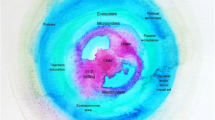Abstract
In many early childhood classrooms, visual arts experiences occur around a communal arts table. A shared workspace allows for spontaneous conversation and exploration of the art-making process of peers and teachers. In this setting, conversation can play an important role in visual arts experiences as children explore new media, skills, and ideas. The investigation of informal conversations during visual arts experiences will serve to improve understandings of the cognitive, imaginative, social, and affective components of young children’s creative endeavors. In particular, the exploration of conversational discourse contributes to understandings of conversation as an integral component of pedagogy in early childhood arts. As an exploration of the nature of conversation as pedagogy in early arts experiences, I present a ‘telling case’ (Mitchell 1984) featuring the collaborative work between a teaching artist and two young students as they explore and create together. The findings from this research have important implications for early childhood and art education teacher educators striving to develop supportive educational practices that will assist early childhood teachers in promoting supportive visual arts practices.




Similar content being viewed by others
Notes
All participant names have been substituted with pseudonyms to protect confidentiality.
Work session times were open-ended and determined by the interest level of the children. Children were free to leave a work session at any time and otherwise participate in the “free choice” time in the classroom.
References
Baker, D. (1994). Toward a sensible education: Inquiring into the role of the visual arts in early childhood education. Visual Arts Research, 20(2), 92–104.
Bereiter, C. (1994). Implications of postmodernism for science, or, science as progressive discourse. Educational Psychologist, 29(1), 3–12.
Bransford, J. D., Brown, A. L., & Cocking, R. R. (2000). How people learn: Brain, mind, experience, and school. Washington, DC: National Academy Press.
Bresler, L. (1993). Three orientations to arts in the primary grades: Implications for curriculum reform. Arts Education Policy Review, 94(6), 29–34.
Bresler, L., DeStefano, L., Feldman, R., & Garg, S. (2000). Artists-in-residence in public schools: Issues in curriculum, integration, and impact. Visual Arts Research, 26(1), 13–29.
Cazden, C. B. (2001). Classroom discourse: The language of teaching and learning (2nd ed.). Portsmouth, NH: Heinemann.
Cotner, T. L. (2010). Teacher art talk: What we say matters. Visual Arts Research, 36(1), 73–84.
Cotner, T. L. (2011). Speaking of art, listening to what teachers are saying. Art Education, 64(2), 12–17.
Danko-McGhee, K. (2000). The aesthetic preferences of young children. New York, NY: Mellon press.
ECAE (Early Childhood Art Educators). (2006). Art: Essential for early learning. A position paper. National Art Education Association Early Childhood Art Educators Issues Group (ECAE). Unpublished paper.
Eckhoff, A. (2006). Influences on children’s aesthetic responses: The role of prior knowledge, contexts, and social experiences during interactions with the visual arts. Unpublished doctoral dissertation, University of Colorado, Boulder, CO.
Eckhoff, A. (2011). Art experiments: Introducing an artist-in-residence program in early childhood education. Early Child Development and Care, 181(3), 371–385.
Efland, A. (2002). Art and cognition: Integrating the visual arts in the curriculum. New York, NY: Teachers College Press.
Eisner, E. (2002). What the arts do for the young. School Arts, 2(1), 16–17.
Feeney, S., & Moravcik, E. (1987). A thing of beauty: Aesthetic development in young children. Young Children, 42(6), 7–15.
Franklin, E. (2005). Assessing teaching artists through classroom observation. Teaching Artist Journal, 3(3), 148–157.
Garvis, S., & Pendergast, D. (2011). An investigation of early childhood teacher self-efficacy beliefs in the teaching of arts education. International Journal of Education & the Arts, 12(9). Retrieved January 12, 2012 from http://www.ijea.org/v12n9/.
Gee, J. P. (1996). Social linguistics and literacies: Ideology in discourses (2nd ed.). London: Taylor and Francis.
Geist, E., & Horn, J. (2009). Encouraging creativity in the face of administrative convenience: How out schools discourage divergent thinking. Education, 130(1), 141–150.
Glasser, B., & Strauss, A. (1967). The discovery of grounded theory: Strategies for qualitative research. Chicago, IL: Adeline.
Hetland, L., Winner, E., Veenema, S., & Sheridan, K. (2007). Studio thinking: The real benefits of visual arts education. New York, NY: Teachers College Press.
Leinhardt, G., & Knutson, K. (2004). Listening in on museum conversations. Walnut Creek, NY: AltaMira Press.
Meban, M. (2002). The Postmodern artist in the school: Implications for arts partnership programs. International Journal of Education & the Arts, 3(1). Retrieved March 17, 2009 from http://www.ijea.org/v3n1/.
Mitchell, J. C. (1984). Typicality and the case study. In R. Ellen (Ed.), Ethnographic research: A guide to general conduct (pp. 238–241). New York, NY: Academic Press.
Orfali, A. (2004). Artists working in partnership with schools. England: Arts Council England.
Schirrmacher, R. (2002). Arts and creative development for young children (4th ed.). New York, NY: Delmer Press.
Seefeldlt, C. (1995). Art: A serious work. Young Children, 45(3), 39–45.
Stein, D. (2004). Wearing two hats: The case of the visiting artist. TheGoodWork® Project. Report Series, Number 29. Boston, MA: Harvard University.
Strauss, A., & Corbin, J. (1990). Basics of qualitative research: Grounded theory procedures and techniques. Newbury Park, CA: Sage Publications.
Striker, S. (2001). Young at art: Teaching toddlers self-expression, problem solving skills and an appreciation for art. New York, NY: Henry Holt.
Thompson, C. M. (1995). The visual arts and early childhood learning: Changing contexts and concepts. In C. M. Thompson (Ed.), The visual arts in early childhood learning (pp. 1–5). Reston, VA: National Art Education Association.
Wells, G., & Arauz, R. M. (2006). Dialogue in the classroom. The Journal of the Learning Sciences, 15(3), 379–428.
Author information
Authors and Affiliations
Corresponding author
Rights and permissions
About this article
Cite this article
Eckhoff, A. Conversational Pedagogy: Exploring Interactions Between a Teaching Artist and Young Learners During Visual Arts Experiences. Early Childhood Educ J 41, 365–372 (2013). https://doi.org/10.1007/s10643-012-0567-0
Published:
Issue Date:
DOI: https://doi.org/10.1007/s10643-012-0567-0




